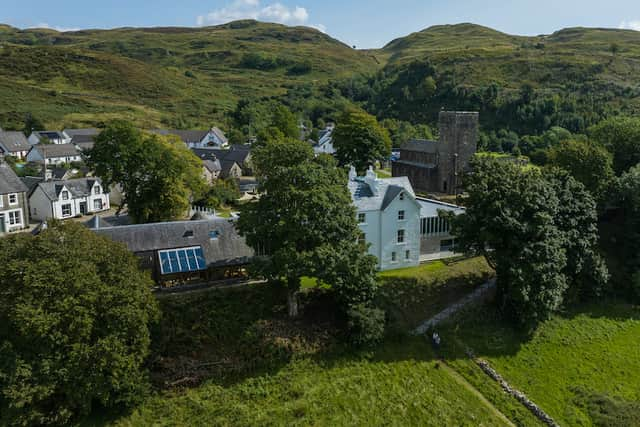West coast museum reopens near Glasgow to display 12,000 year old artefact
and live on Freeview channel 276
A west coast museum reopened yesterday (Sunday, September 3) in Kilmartin near Lochgilphead in Argyll & Bute - and is now set to display its collection detailing over 12,000 years of archaeological history from western Scotland and it’s isles.
Kilmartin Museum opened to the public yesterday on the first Sunday of September after closing in 2021 for renovation.
Advertisement
Hide AdAdvertisement
Hide AdThe renovation of the museum brings to the Argyll village of Kilmartin a much larger exhibition space, a learning space to deliver and participate in cultural and educational activities, new galleries to house temporary art exhibitions, laboratories in which to process new finds and acquisitions in Kilmartin Glen, and an art collection store.
The new museum was designed by Reiach and Hall Architects to highlight the connection between the artefact and its surrounding prehistoric landscape.
The re-opening allows much of the ‘nationally significant collection’ status items Kilmartin Museum holds to be displayed for the first time. There are currently over 11,000 prehistoric artefacts held by the historical education centre gathered from the surrounding land of Kilmartin Glen and the western isles of Scotland.
Kilmartin Museum will bring to life 12,000 years of history using stories and visualisations around their existing artefacts.
Collection highlights include:
Advertisement
Hide AdAdvertisement
Hide Ad- the remains of a Bronze Age woman found in Kilmartin Glen, displayed alongside a reconstruction of her face, allowing visitors to look into the eyes of their ancestor;
- Mesolithic flint core, 12,000 years old, one of few artefacts representing some of the first evidence of human presence in Kilmartin Glen;
- Axe heads, possibly buried as part of a ceremony, one has stylistic qualities the are traditionally Irish and the other typically Scottish;
- Three Beaker pots, from a grave of a person who originated on the continent.
The Museum also showcases over 60 loans from National Museums Scotland relevant to western Scotland, including:
- The Poltalloch jet necklace – a piece of internationally important Bronze Age jewellery from Kilmartin Glen
- The stunning Glebe Cairn vessel, displayed with a view towards the Bronze Age cairn it was found in
Several more objects are exhibited on loan from the British Museum.
Dr Sharon Webb, Museum Director and Curator said: “We’re so excited to be opening the new museum finally after many challenges, including the global pandemic. Kilmartin Glen’s archaeological landscape and the artefacts found here are internationally significant, and it’s been a privilege to have been part of the team telling their story in the new exhibition.
“We’ve been able to display many more of our own collections, most of which are recognised as Nationally Significant. The new museum facilities also mean that we can welcome visitors, undertake educational activities and research into this amazing legacy. Importantly, the new building also allows us to professionally curate our own archaeological collections and those of Argyll and Bute Council which we also care for.”
Advertisement
Hide AdAdvertisement
Hide Ad

Within a stone’s throw of the museum, visitors are able to enjoy several sites offering a fascinating insight into prehistoric times, including:
- Kilmichael Glassary Rock Art: 5,000-year-old rock art featuring motifs such as cup and ring marks. Similar carvings are observed in other rock art sites in Kilmartin: Cairnbaan and Achnabreck. The Kilmichael Glassary site also features several unusual keyhole-shaped carvings.
- ‘Linear cemetery’: a 2km long line of five cairns, dating about 5,000 to 3,500 years ago. It includes -
- Nether Largie Mid Cairn, the high-status burial monument featuring the rare axe-head carvings found in one of the cairn’s two cists. The carvings suggest this was the burial place of a high-status individual since axes are thought to be indicators of wealth);
- Nether Largie North, Nether Largie South Cairn and Glebe Cairn. The Glebe Cairn is through to contain at its centre two concentric rings of boulders, with a burial cist placed in the centre.
- Ri Cruin, the southernmost point of the prehistoric ‘linear cemetery’ which was extensively damaged in the 1700s and 1800s.
- Temple Wood Stone Circle: a complex ritual and funerary site which was in use for more than 2,000 years (before 3000 BC and continued into the Bronze Age, ending about 1000 BC). It features 13 standing stones, one of them marked with a spiral which is a motif closely paralleled in Irish passage-grave art.
The Glen is also home to one of Scotland’s most important early mediaeval sites - Dunadd Fort. It rises proudly from the Moine Mhòr – the ‘great moss’ – in the southern end of Kilmartin Glen. It was home to a fort 2,000 years ago, and a royal power centre of Gaelic kings in the 500s to 800s AD.
The museum’s curators share fresh insights, from the newly discovered techniques used to create one of Europe’s largest concentrations of prehistoric rock art to revealing the story of a Neolithic Cursus – and its staggering destruction which involved burning of nearly 400 oak trees at the point where humans started to make their impact on the landscape known.
Two galleries for special exhibitions have been added to the Museum, and locally based artist Lizzie Rose takes the Cursus as the inspiration for her new exhibition Carbon Legacy.
Advertisement
Hide AdAdvertisement
Hide AdReflecting the need for our collective action against climate crisis, Carbon Legacy is an installation which includes nearly 400 oak tree seedlings which will later be planted in a collaborative action, creating a living monument in Kilmartin Glen near the original site of Neolithic Cursus.
Museum Collections will also present artworks of four other local artists who were commissioned by the Museum to create work to celebrate the opening of the Museum.
Comment Guidelines
National World encourages reader discussion on our stories. User feedback, insights and back-and-forth exchanges add a rich layer of context to reporting. Please review our Community Guidelines before commenting.
